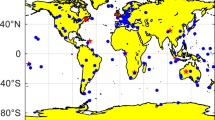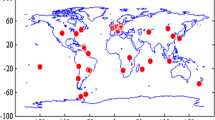Abstract
Significant time-varying inter-frequency clock biases (IFCBs) within GPS observations prevent the application of the legacy L1/L2 ionosphere-free clock products on L5 signals. Conventional approaches overcoming this problem are to estimate L1/L5 ionosphere-free clocks in addition to their L1/L2 counterparts or to compute IFCBs between the L1/L2 and L1/L5 clocks which are later modeled through a harmonic analysis. In contrast, we start from the undifferenced uncombined GNSS model and propose an alternative approach where a second satellite clock parameter dedicated to the L5 signals is estimated along with the legacy L1/L2 clock. In this manner, we do not need to rely on the correlated L1/L2 and L1/L5 ionosphere-free observables which complicates triple-frequency GPS stochastic models, or account for the unfavorable time-varying hardware biases in undifferenced GPS functional models since they can be absorbed by the L5 clocks. An extra advantage over the ionosphere-free model is that external ionosphere constraints can potentially be introduced to improve PPP. With 27 days of triple-frequency GPS data from globally distributed stations, we find that the RMS of the positioning differences between our GPS model and all conventional models is below 1 mm for all east, north and up components, demonstrating the effectiveness of our model in addressing triple-frequency observations and time-varying IFCBs. Moreover, we can combine the L1/L2 and L5 clocks derived from our model to calculate precisely the L1/L5 clocks which in practice only depart from their legacy counterparts by less than 0.006 ns in RMS. Our triple-frequency GPS model proves convenient and efficient in combating time-varying IFCBs and can be generalized to more than three frequency signals for satellite clock determination.




Similar content being viewed by others
References
Boehm J, Werl B, Schuh H (2006) Troposphere mapping functions for GPS and very long baseline interferometry from European Centre for Medium-Range Weather Forecasts operational analysis data. J Geophys Res 111(B2):1059–1075
Cocard M, Bourgon S, Kamali O, Collins P (2008) A systematic investigation of optimal carrier-phase combinations for modernized triple-frequency GPS. J Geod 82(9):555–564
Dai Z, Knedlik S, Loffeld O (2009) Instantaneous triple-frequency GPS cycle-slip detection and repair. Int J Navig Observ. https://doi.org/10.1155/2009/407231
deLacy MC, Reguzzoni M, Sansò F (2012) Real-time cycle slip detection in triple-frequency GNSS. GPS Solut 16(3):353–362
Feng Y (2008) GNSS three carrier ambiguity resolution using ionosphere-reduced virtual signals. J Geod 82(12):847–862
Ge M, Gendt G, Rothacher M, Shi C, Liu J (2008) Resolution of GPS carrier-phase ambiguities in precise point positioning (PPP) with daily observations. J Geod 82(7):389–399
Geng J, Bock Y (2013) Triple-frequency GPS precise point positioning with rapid ambiguity resolution. J Geod 87(5):449–460
Geng J, Bock Y (2016) GLONASS fractional-cycle bias estimation across inhomogeneous receivers for PPP ambiguity resolution. J Geod 90(4):379–396
Geng J, Shi C (2017) Rapid initialization of real-time PPP by resolving undifferenced GPS and GLONASS ambiguities simultaneously. J Geod 91(4):361–374
Geng J, Meng X, Dodson AH, Teferle FN (2010a) Integer ambiguity resolution in precise point positioning: method comparison. J Geod 84(9):569–581
Geng J, Meng X, Dodson AH, Ge M, Teferle FN (2010b) Rapid re-convergences to ambiguity-fixed solutions in precise point positioning. J Geod 84(12):705–714
Guo F, Zhang X, Wang J, Ren X (2016) Modeling and assessment of triple-frequency BDS precise point positioning. J Geod 90(11):1223–1235
Hauschild A, Steigenberger P, Rodriguez-Solano C (2012) Signal, orbit and attitude analysis of Japan’s first QZSS satellite Michibiki. GPS Solut 16(1):127–133
Li H, Zhou X, Wu B, Wang J (2012) Estimation of the inter-frequency clock bias for the satellites of PRN25 and PRN01. Sci China Phys Mech Astron 55(11):2186–2193
Li H, Zhou X, Wu B (2013) Fast estimation and analysis of the inter-frequency clock bias for Block IIF satellites. GPS Solut 17(3):347–355
Li H, Li B, Xiao G, Wang J, Xu T (2016) Improved method for estimating the inter-frequency satellite clock bias of triple-frequency GPS. GPS Solut 20(4):751–760
Montenbruck O, Hauschild A, Steigenberger P, Langley RB (2010) Three’s the challenge: a close look at GPS SVN62 triple-frequency signal combinations finds carrier-phase variations on the new L5. GPS World 21(8):8–19
Montenbruck O, Hugentobler U, Dach R, Steigenberger P, Hauschild A (2011) Apparent clock variations of the Block IIF-1 (SVN62) GPS satellite. GPS Solut 16(3):303–313
Montenbruck O, Hauschild A, Steigenberger P, Hugentobler U, Teunissen P, Nakamura S (2013) Initial assessment of the COMPASS/BeiDou-2 regional navigation satellite system. GPS Solut 17(2):211–222
Odijk D, Teunissen PJG (2013) Characterization of between-receiver GPS-Galileo inter-system biases and their effect on mixed ambiguity resolution. GPS Solut 17(4):521–533
Odijk D, Zhang B, Khodabandeh A, Odolinski R, Teunissen PJG (2016) On the estimability of parameters in undifferenced, uncombined GNSS network and PPP-RTK user models by means of S-system theory. J Geod 90(1):15–44
Odolinski R, Teunissen P, Odijk D (2014) First combined COMPASS/BeiDou-2 and GPS positioning results in Australia. Part II: single- and multiple-frequency single-baseline RTK positioning. J Spat Sci 59(1):25–46
Pan L, Zhang X, Li X, Liu J, Li X (2016) Characteristics of inter-frequency clock bias for BLOCK IIF satellites and its effect on triple-frequency GPS precise point positioning. GPS Solut. https://doi.org/10.1007/s10291-016-0571-8
Paziewski J, Wielgosz P (2015) Accounting for Galileo-GPS inter-system biases in precise satellite positioning. J Geod 89(1):81–93
Schaer S (2016) SINEX_BIAS—Solution (Software/technique) Independent Exchange Format for GNSS Biases Version 1.00. IGS workshop on GNSS biases, Bern, Switzerland
Schaer S, Steigenberger P (2006) Determination and use of GPS differential code biases values. In: Proceedings of IGS workshop, Darmstadt, Germany, May 8–11
Schmid R, Steigenberger P, Gendt G, Ge M, Rothacher M (2007) Generation of a consistent absolute phase center correction model for GPS receiver and satellite antenna. J Geod 81(12):781–798
Schönemann E, Becker M, Springer T (2011) A new approach for GNSS analysis in a multi-GNSS and multi-signal environment. J Geod Sci 1(3):204–214
Steigenberger P, Rodriguez-Solano C, Hugentobler U, Hauschild A, Montenbruck O (2013) Orbit and clock determination of QZS-1 based on the CONGO network. J Inst Navig 60(1):31–40
Zhang B, Teunissen PJG, Odijk D, Ou J, Jiang Z (2012) Rapid integer ambiguity-fixing in precise point positioning. Chin J Geophys 55(7):2203–2211
Zhao Q, Wang G, Liu Z, Hu Z, Dai Z, Liu J (2016) Analysis of BeiDou satellite measurements with code multipath and geometry-free ionospheric-free combinations. Sensors 16(1):123
Zumberge JF, Heflin MB, Jefferson DC, Watkins MM, Webb FH (1997) Precise point positioning for the efficient and robust analysis of GPS data from large networks. J Geophys Res 102(B3):5005–5017
Acknowledgements
This work is funded by National Science Foundation of China (No. 41674033) and State Key Research and Development Program (2016YFB0501802). We thank IGS for the GPS observations and precise satellite products which enable this study. We are also grateful for the high computing facility at Wuhan University which bolsters all the computational work of this study.
Author information
Authors and Affiliations
Corresponding author
Appendix: Hardware biases assimilated into observation residuals
Appendix: Hardware biases assimilated into observation residuals
These equations complement Eqs. (2) and (4) by stating how hardware biases affect the pseudorange and carrier-phase residuals in our model for undifferenced uncombined triple-frequency GPS data processing. Note that parameters e (indices are ignored) do not denote observation residuals, but the time-varying hardware biases that are assimilated into observation residuals. We can find that all pseudorange residuals on L1, L2 and L5 contain both time-varying pseudorange and carrier-phase hardware biases. There are no hardware biases assimilated into carrier-phase residuals except those for L5.
Rights and permissions
About this article
Cite this article
Guo, J., Geng, J. GPS satellite clock determination in case of inter-frequency clock biases for triple-frequency precise point positioning. J Geod 92, 1133–1142 (2018). https://doi.org/10.1007/s00190-017-1106-y
Received:
Accepted:
Published:
Issue Date:
DOI: https://doi.org/10.1007/s00190-017-1106-y




